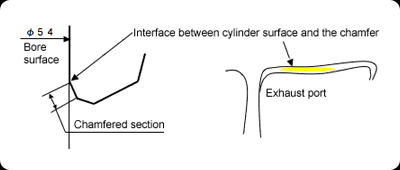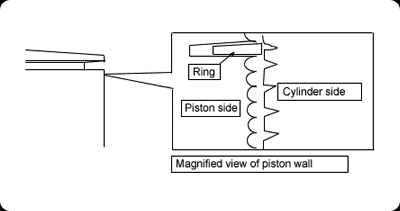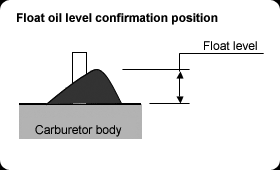|
TECHNICAL INFORMATION
NOTES ON MAINTENANCE
(ENGINE),
RS125R / RS250R


| The RS provides the high potential for circuit use. Lack of the basic maintenance, however, will result largely degraded performance. Servicing should be regularly performed and parts be periodically replaced, if needed. |
| Periodic replacement parts |
| |
| Item |
Intervals |
Criteria |
| Plug cap |
Every 1000km (cleaning for each maintenance) |
|
| Cylinder |
Every 2000km |
Wear or damage |
| Piston |
Every 500km |
Damaged skirt or wear |
| Piston ring |
Every 500km |
Partial loss of identification point, wear |
| Piston pin clip |
Every 500km |
Burning, damage, stepped wear |
| Piston pin clip |
Every 300km (Every time clip is removed) |
|
| Connecting rod small end bearing |
Every 500km |
Burning, wear, damage |
| Crank shaft |
Every 2000km |
Deformation, damage |
| Clutch outer |
Every 2000km |
Wear, damage |
| Spark plug |
|
Wear |
| Ignition coil |
|
Wear, damage |
| Reed valve |
|
Loose, damage |
|
|
| |
| Overhaul |
| |
| Item |
Interval |
| Front/rear suspension |
Every 2000 km or every 4 races |
| Cables (throttle or clutch) |
Every 2 to 3 races (every time races are done in a rainy day) |
| Brake master cylinder |
Every season |
| Steering stem |
Every season (check needed after falling down) |
| Suspension link section |
At new vehicle, every time parts replaced |
| Wheel bearing |
Abnormal noise, play, defective operation |
|
|
| |
| Checking other fasteners |
| |
Check the brake system, front section, or rear axle section for loose fasteners. Also check wire lock.
Reasons for specifying intervals in terms of kilometers for periodic replacement parts
Example: Pistons for which replacement is specified at every 500km
| Durability: |
Reduced streaks on piston surface (oil bank) |
| occurrence of cracks |
| Degraded performance: |
Deformed pistons |
| Blow up (ring grooves struck by rings, wear) |
As described above, intervals in km are the ranges within which an appropriate racer can provide its inherent high performance or which will not cause durability related failure. (Likewise, these intervals have been specified for other parts. See owners manual) |
|
| |
| Cylinder |
| |
With increased power, the 2001 model year RS125R and RS250R have cylinder bore shape and timing similar to the manufacturer's kit engine.
Accordingly, cylinder maintenance has become more important than before.
Basically, it is recommended that the items described in the manual be followed. In particular, mentioned below is the description on the necessity for chamfering. |
|
| |
 |
|
| |
The chamfer on the upper surface of the exhaust port may be glittering when obliquely viewed from the skirt side of the cylinder taken from engines which have traveled to some degree. |
|
| |
 |
|
| |
The figure above shows a magnified view of the cross section of the port chamfer. The piston ring slightly protrudes into the exhaust port when the piston goes up and down.
This chamfer again rests in the bore surface. If there is, however, an angular (even obtuse-angle) section at the cylinder chamfer interface section, the piston ring movement gradually becomes bad, resulting in strengthened contact by the ring on chamfers.
For this reason, chamfer should be made. When chamfering is made for upper and lower ports, wet abrasive papers will be applied to the interface of the bore surface and the port chamfer at small angles (10 to 15 degrees) to make the interface round.
Chamfer maintenance would avoid stuck rings or peeled plate at the cylinder port. |
|
| |
 |
|
| |
| Piston |
| |
Piston contact
Piston contact should not usually be removed. Severe contact with the cylinder is attributed to some other reasons. Pistons have special profile (out of round), which is designed to produce heat emission, providing proper contact when pistons and cylinders are subject to deformation.
Accordingly, careless piston modifications in profile will degrade the ideal profile, resulting in more contact with other portions. |
|
| |
 |
|
| |
| Ring sticking |
| |
With the increase of service engine speeds year after year, even if keystone rings are used, sticking may result.
If rings and pistons are new, ring groove modifications are not required against sticking. However, if stuck rings are found at the time of maintenance, the modifications must be done. Stuck rings may cause engine troubles as well as a significant power drop.
Stuck rings can be identified by signs of a failure exhibited at the engine start, such as unwillingness to start engines or abnormal engine noise emitted from the silencer. |
 |
|
| |
| Piston rings |
| |
The abutment of piston rings should be chamfered at the gap using a round file. This is intended to prevent stopper pins from being cut by rotational force generated when pistons are moving up and down. |
 |
|
| |
| Piston sizes (applicable until the year 2002 RS250R) |
| |
Cross reference of piston and cylinder combination |
|
| |
 |
|
| |
*Cylinders for the 2001 year and later models bear no A/B identification markings. Instead, they have NXA stamped at the side. |
|
| |
| Handling cylinders and cylinder heads |
| |
Extreme care should be exercised during handling cylinders or cylinder heads.
In particular, flawed mating faces may deteriorate adherence, causing blow by.
If there are projections caused by flaw or dent, they should be removed using abrasive paper to make the surface flat.
However, if flaws are present across O-rings or flaws are present in the O-ring grooves, appropriate cylinders or cylinder heads should not be used since O-rings cause blow by. |
|
| |
| RC valve (applicable until 2002 year RS250R) |
| |
For the RS250R, unadjusted RC valves will result in significant power drop (1 to 5 PS). Even if piston maintenance is not performed, RC valves, once heated, should be readjusted since the valves displace. |
|
| |
| Clutch outer section |
| |
The clutch outer section should be periodically serviced and replaced if necessary. If excessive plays or cracks are found during servicing, defective parts should be replaced as soon as possible. (clutch outer fasteners)
(Protruded fasteners may damage pulsar plates for the RS125R or casing cover for the RS250R.) |
|
| |
| Water seal |
| |
When water pump seals are replaced to fix coolant leak from water pump, water pump shaft should be visually checked. If the shaft exhibits color change or rough surface, just seal replacement will not solve the problem. In this case, both seals and shafts should be replaced. If coolant leak is again found after replacement of both parts, water pump bearing and balancershaft bearing should be replaced as well. |
|
| |
| Carburetor |
| |
When cleaning carburetors, do not apply high pressure air to carburetors with floats installed. High pressure air would cause oil level in carburetors to get out of order, resulting in significantly wrong settings. |
|
| |
| Carburetor float |
| |
Carburetor float section is a very delicate part. Extreme care should be exercised during disassembly.
If oil level should go wrong, see owners' manual for proper adjustment. Wrong oil level would cause rich or lean mixture, or hesitation. Also, check that floats are smoothly going up and down.
If floats do not move smoothly, rich feeling or hesitation may result when beginning to open the throttle. Also, unstable fuel mixture would cause frequent detonation. |
|
| |
|
|
| |
Float oil level confirmation position |
|
| |
 |
|
| |
Float level should be checked at the point at which float valve comes into slight contact with float lip.
Oil level height should be measured at the highest point of the float, instead of at the point of main jet. |
|
| |
2001 year model cylinder head
Secondary volume for the 2001 and later models is less than that for 2000 and earlier modeled by 0.2cc in cylinder head volume. The 2001 year model has a cylinder head with the center protruded, making impossible the measurement of the volume when the head assembled (because of creation of air puddle). Single head only allows measurement. |
| |
| Secondary volume criteria |
| Item |
Volume when assembled |
Single head volume |
| '00 |
11.6cc |
11.1cc |
| '01 |
11.4cc |
10.9cc |
|
Non-standard combination will result in unwillingness to rev highly and vibration, leading to deteriorated potential performance.
The 2000 year model exhaust joint is different in joint diameter from the 2001 year model, making impossible its common use. |
| Exhaust joint |
| |
The 2001 year model has exhaust joint length and color which are opposed to the 2000 year model.
|
| |
Machine |
#1 front side |
#2 rear side |
| |
'00model |
34.2mm black |
29.2mm silver white |
| |
'01model |
27.5mm silver white |
29.5mm black |
| |
|
| |
Non-standard combination will result in unwillingness to rev highly and vibration, leading to deteriorated potential performance.
The 2000 year model exhaust joint is different in joint diameter from the 2001 year model, making impossible its common use. |
| Exhaust joint gasket |
| |
The 2001 year model has a thin stainless gasket in comparison with its former thick copper gasket (for improved durability). Accordingly, like installation of exhaust joints to chambers, liquid gasket should be applied before exhaust joints are installed. |
| Reed valve |
| |
The 2001 year and later model has undergone changes to a reed valve body, having altered angle as compared with 2000 year model (2001 model has steep angles).
Making reed valves thinner allows easy opening, and installation of supports secures functioning of valves when wide-open.
As described in the manual, valves, supporter and stoppers should be so installed to ensure their position. |
|
|
|
|
|
|
|
|
Redline
Powersports provides the above information as a courtesy; it is the
reader's responsibility to confirm the accuracy and applicability of
all information before performing any of the discussed adjustments,
modifications, procedures, etc; furthermore, the implementation of
any of the discussed adjustments, modifications, procedures, etc is
done at the sole risk of the reader. Redline
Powersports does NOT warranty or guarantee in any way the
information discussed in it's "Technical Information" pages or
elsewhere. Redline Powersports disclaims all responsibility
for consequential and incidental damages or any other loss arising
from the use of ANY information provided by Redline Powersports
and/or itís vendors, suppliers, contractors, etc. irrespective of
how caused.
|
|